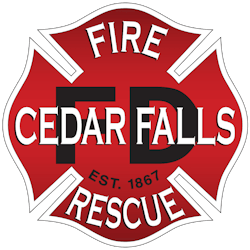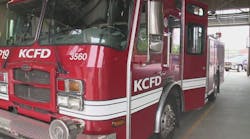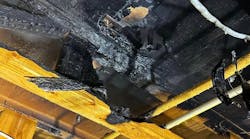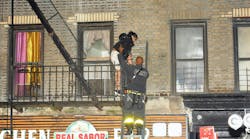CEDAR FALLS, IA—At 8:40 a.m. Sept. 10, 2018, Cedar Falls dispatched four fire-response units — including a rescue truck with special “confined space” equipment — to the University of Northern Iowa, where a massive amount of steam was spewing from the campus Commons.
But “due to staffing,” only two of the four units rushed to the scene, arriving five minutes later. The truck with confined-space equipment was redirected, showing up 30 minutes after the first call. A ladder truck also dispatched never came.
RELATED:
- IA Firefighters Quit over PSO Safety Concerns
- IA City Approves PSOs amid FF Criticism
- Fifth IA Firefighter Resigns in PSO Spat
- Resignations Continue at IA Fire Department
As the initial crew of seven firefighters crafted a plan to retrieve a UNI worker they understood to be inside the campus’ compromised steam system, they assumed roles and assigned posts — including one that called on a captain to take on a different job — again, “due to staffing.”
Amid the mayhem, longtime UNI steamfitter Kevin Bley, 61, died as scalding water that day spread in the tunnel, part of a utility system that supplies heat on campus.
Now a year later, The Gazette has obtained the long-suppressed details of the first crucial moments on scene as told by then-Cedar Falls fire Capt. Josh Lux, who had a firsthand view of the incident that turned fatal, launched an investigation confirming “serious” safety violations at UNI and again raised questions about the city’s controversial public safety model.
“The public safety officer program has created responders that have never passed a firefighter physical agility test, that are trained to the lowest levels in the state of Iowa for cities the size of Cedar Falls,” said Scott Dix, a 24-year firefighting veteran and president of Cedar Falls Firefighters Local 1366. “The PSO program has created responders that are, at best, mediocre at being a police officer and a firefighter, and an expert at neither.”
The yearslong dispute over the city’s public safety model — a collaboration between the fire and police departments involving cross-trained public safety officers — has featured helmet camera video appearing to show delays at emergencies, internal probes and a raft of resignations.
The response to the UNI emergency serves as a microcosm for the public safety model debate and poses important questions not just for citizens across its service area but for the financially strapped UNI, which for nearly two decades has paid hundreds of thousands of dollars for the city’s fire protection services.
In agreeing to cover 16 percent of Cedar Falls’ net annual fire department expenses in exchange for its protection — including confined space rescue — the public university in the 2019 budget year paid the city more than $525,000.
“Here, you have a contract where UNI is expecting service from the city of Cedar Falls — but that contract is thin on details,” former Cedar Falls firefighter and former state lawmaker Jeff Danielson told The Gazette. “I think it would behoove the leaders of UNI to ask more questions about the kind of service capability that Cedar Falls has in the context of this incident.”
When asked about its service capacity under the public safety model — and its response to the UNI incident specifically — city officials told The Gazette the program has enabled it to increase the number of firefighters at fires and the number of police on patrol.
City officials, additionally, noted that UNI has said it’s satisfied with the city’s partnership.
Asked about the fatal steam tunnel incident and Cedar Falls’ response to it — including that confined space rescue equipment initially was redirected — UNI provided a statement acknowledging the “terrible tragedy.”
The statement also noted that Cedar Falls responders eventually determined their task that day was a “recovery” and not a rescue.
“The university remains appreciative of the recovery effort from the many individuals who responded, including those from Cedar Falls Fire Rescue,” UNI said in a statement. “They responded in a manner consistent with the agreements in place between the university and the City of Cedar Falls.”
‘There’s somebody in the steam tower’
According to multiple officer and firefighter narratives — including the official report and 9-1-1 calls obtained by The Gazette — crews did not immediately know, however, that Bley had died.
“We’ve got massive amounts of steam … steam in the building at UNI Towers Center … so much they can’t enter,” according to a 911 dispatcher who requested four fire units respond. “I have someone on the phone right now saying that there’s somebody in the steam tower.”
A firefighter replied, according to the 9-1-1 calls, that two of the trucks actually were not in route — including the one with confined space rescue equipment.
Upon arrival, crews learned more about “a missing man in the tunnels,” according to the city report, which it labeled a “confined space rescue.” A UNI maintenance official told responders he knew of only one possible victim, and employees had “been trying to reach the victim by radio and cellphone,” according to the report.
The city said in a statement that seven career firefighters responded to the scene, where they were met by 10 of the public safety officers, the city’s fire chief and a battalion chief.
That battalion chief — Capt. Robert Inouye — confirmed the steam tunnel qualified as a “confined space,” according to the official report.
Using ropes and a tunnel map, two firefighters — Lux and Jason Campbell — made entry about five minutes after arrival, Lux reported.
According to Lux’s narrative, he and Campbell proceeded into the tunnel, where temperatures soared and they encountered standing scalding water.
Lux reported his feet began to burn as Campbell found the victim “face down” in the water.
With the operation now shifting to a recovery, Lux retreated to receive treatment for minor burns. Campbell soon followed, also sustaining burns to his feet that warranted transport to a hospital.
Once crews managed to remove the searing water, firefighters re-entered the tunnel, with public safety officers assisting. Crews eventually recovered Bley’s body and fire units cleared the scene at 10:44 a.m., a dispatch report shows.
The city of Cedar Falls quashed Lux’s report from being made public, asserting it contained “false information.” But The Gazette later obtained it and confirmed key details about dispatch times and 9-1-1 calls with other city records.
UNI’s fire contract ‘very ambiguous’
Capt. Inouye, among the department’s many firefighters who since have resigned, said that in hindsight, the confined space equipment should have been among the first on scene.
But with the way the call came in and with the number of firefighting personnel available, he said, crews took two engines and left behind the ladder and rescue trucks.
“If we had more staff, it would have been easier. It would have just happened,” said Inouye, whose comments align with Lux’s statement that two trucks didn’t respond to the initial dispatch “due to staffing.”
Cedar Falls officials, in their response to The Gazette, said a fire supervisor with two decades of experience determined the confined space equipment was not needed, based on the initial call.
It was only “upon arrival” the department learned someone might be in the steam tunnel.
“At that time, the fire supervisor called for the confined space materials,” according to the Cedar Falls statement.
The Gazette confirmed that Cedar Falls at 9:07 a.m. re-dispatched the rescue truck it initially had sought to dispatch 27 minutes earlier.
Inouye said he doesn’t have a full grasp of UNI’s public safety agreement with Cedar Falls, and therefore can’t speak to whether the city upheld its obligations.
Jason Kayser, a fire and safety specialist working for UNI at the time of the incident, said the contract is outdated and “very ambiguous.”
“I don’t even know if anyone could violate that contract, just because of how vague the language was,” he said. “There are no real guidelines.”
When asked whether Cedar Falls response to the UNI emergency was adequate, he said, “No.”
“Would I consider it adequate?” he said, “No, I wouldn’t.”
Former Cedar Falls firefighter Danielson, who left his seat in the Iowa Senate when he resigned from the fire department in February, said he thinks the incident should propel change across the community — including UNI.
“I think there are a lot of lessons to be learned from this incident, and I think the decision-makers need to think about the capability of Cedar Falls’ ability to respond to these incidents,” he said. “I think UNI and its leadership should consider strongly its requirements that it’s expecting from the city of Cedar Falls for fire and other safety matters.”
‘Inaccurate’ report on response released
Following the UNI tragedy, the Iowa Occupational Safety and Health Administration launched an investigation, uncovering five “serious” safety violations costing the university $14,000 in fines. UNI also hired an engineering company to assess the root cause of the fatal leak — revealing a faulty cap likely was to blame.
In the days and weeks that followed, resignations among Cedar Falls firefighters mounted — depleting a staff of over 30 and replacing the former firefighters with public safety officers.
Those officers — a sort of hybrid responder cross-trained for both police and fire duties — are the result of the 2015 formation of the Cedar Falls public safety model, meant to “more effectively provide security in our community.”
“I don’t feel it’s a safe environment to be in,” said Sharon Regenold, a former Cedar Falls fire captain who spent 21 years with the department before retiring in 2017 at age 55. “I don’t feel it’s in the best interests of the citizens.”
She said she hadn’t planned to leave that soon, but had concerns about the department’s ability to do its “very very dangerous” job.
After the UNI incident, Lux came under internal investigation for providing “numerous opinions and facts that were completely inaccurate” in his reporting on the steam tunnel response.
The city also accused Lux of refusing to answer supervisor questions and for making a “challenging and disrespectful statement to the public safety director while being served the notice of investigation.”
The city initially refused to release Lux’s “inaccurate” report, prompting a citizen complaint in November 2018 to the Iowa Public Information Board. The board intervened and helped negotiate a resolution involving the release of Lux’s statement, which later was obtained by The Gazette.
Union President Dix said the city instructed members of the department not to comment about the UNI incident or the fallout.
And he said the city omitted Lux’s report in its provisions to Iowa OSHA investigators, who told The Gazette they “don’t know if information was withheld.”
On Oct. 3, 2018, Lux resigned in lieu of termination for “failure to obey a direct order, falsifying an official report, and insubordination.”
Lux’s wife, in a Facebook post, said her husband already had landed another job and given his notice when Cedar Falls asked him to step down.
Lux declined to comment for this article.
Current and former members of the Cedar Falls firefighting unit interviewed by The Gazette praised Lux’s character and integrity, and former Capt. Inouye, who resigned in March, said he believes the city could have handled its concerns better.
“The disciplinary process that was used was unnecessary and could have been handled in a much different way,” he said. “Instead, the public safety administration chose to mete out discipline so it was both a corrective action to that individual but also a warning to the rest of the department.”
———
©2019 The Gazette (Cedar Rapids, Iowa)
Visit The Gazette (Cedar Rapids, Iowa) at thegazette.com
Distributed by Tribune Content Agency, LLC.






